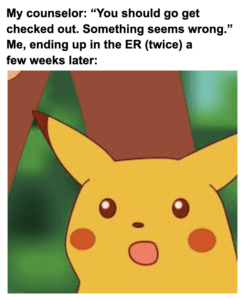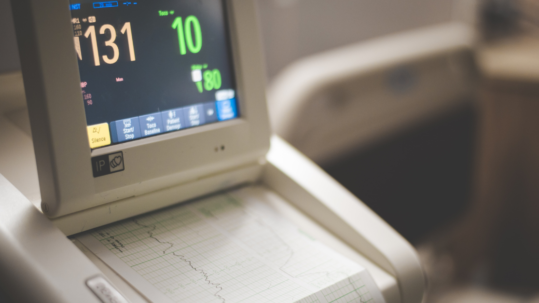
12 Dec Developing POTS – What Is It and What Is It Like?
What is POTS?
Postural Orthostatic Tachycardia Syndrome (POTS) is a condition that primarily impacts a person’s ability to compensate for changes in position/posture, like laying down to sitting or sitting to standing up. For a person with POTS, making these changes in position (especially when done quickly) results in a variety of symptoms like passing out or an absurdly fast heart rate. The condition has to do with inconsistencies in the autonomic nervous system, which controls the things our body does automatically – things like pulse, blood pressure, digestion, breathing, temperature regulation, and more. As one could imagine, the impacts of these core functions have far-reaching impacts on the body, affecting standing, walking, eating, sleeping, driving, exercising, and nearly every other normal activity. There are several ways it can originate: an overactive fight-or-flight response (hyperadrenergic), low blood volume (hypovolemic), or a loss of nerve-to-blood-vessel communication (denervation) are the three main ways. There is also secondary POTS which is the result of a separate primary condition like Ehlers-Danlos syndrome or certain autoimmune diseases.
When a person with POTS stands up from laying down, the blood naturally rushes down with gravity, but unlike a normal person, the body does not compensate well for the change. Ideally, the blood vessels in the lower half of the body would constrict to keep blood flowing upward, the heart rate would slightly rise in order to make a reasonable effort to keep the blood pressure stable, and the kidneys would keep enough blood volume circulating to make sure there is enough to go around. In POTS, there is miscommunication in the body, resulting in blood pooling in the legs, excessive heart rate spikes, and insufficient blood volume to places that need it (you know…like the brain). (Read more about POTS from the experts here)
The criteria for diagnosis is that a person must have an increased pulse of at least 30bpm when they go from laying down to standing up, paired with worsening symptoms associated with POTS (such as passing out/lightheadedness, nausea, chest pain, headache, shakiness, anxiety, tiredness, vision problems, brain fog, etc). A tilt table test (TTT) is the go-to test for POTS (read about my experience with the TTT here).
My Experience with Developing POTS
I wish I knew exactly when I developed POTS. Instead of one dramatic day that I can point to, I have a constellation of moderately inconvenient symptoms that escalated until I realized that something was wrong. But even then – did it develop over the last 5 years? The last 2? The last 6 months? It’s frustratingly hard to tell for a black-and-white thinker like myself. But in sharing a variety of my symptoms, my goal is to not only inform those who are unfamiliar but also to help others identify the symptoms that they may be experiencing but just aren’t “bad enough yet” to investigate. It was because other people were open about their experience that I came to realize that my symptoms matched the POTS description, and I want to pay it forward to whoever might be reading this article searching for answers.
For me, tachycardia (pulse over 100 bpm) is a constant companion whether I’m doing dishes, laundry, showering, cooking, shopping, doing stairs, or just about any other activity that doesn’t include sitting with my feet up. Fatigue demands naps and hours of resting each and every day. Blood pressure swings are intense and abrupt – sometimes I watch it swing up to 50 mmHg within just a few minutes. Nausea comes and goes, then comes again. Each morning when I get out of bed my vision dims and my ears ring, with my heart thumping boldly in my chest. On bad days, I nearly black out each and every time I stand up from a chair. Each “normal life thing” gets to be broken down into baby steps and eaten one bite at a time with incredible awareness each and every step of the way. But that’s not how it started.
For years I have low-key assumed I was anemic (turns out, I’m not), but at the time, I was too hesitant to request a blood test. When I stood up too fast I frequently got the typical lightheadedness and “off” feeling that I had heard was associated with low iron. I’ve also always had problems with circulation in my feet, and when I stand in one spot they tend to get red and sting/feel prickly. In my ignorance, I assumed everyone’s feet got that way, because why else do people complain about their feet hurting after a long day? It wasn’t until later when I was watching a POTS vlog, that I realized it wasn’t normal. She explained how for someone with POTS, the body has a hard time fighting gravity to get the blood back up to the upper half of the body, so oftentimes the blood settles in the feet and can cause them to be red and to feel like they’re burning. I was caught off guard by this discovery, and further intrigued.
Other than that, I was a relatively healthy individual. It was easy to dismiss, and I lived my life. After college graduation in the spring of 2021, I was hired as a summer staffer in the kitchen at a camp in the Northwoods of Wisconsin, and then later became the year-round kitchen assistant. It was a fast-paced and dynamic job that required long hours and a decent amount of physical labor. It was a joy to get to know and work with volunteers of all kinds throughout the fall and winter, to train summer staff leaders to run the kitchen at our busiest, and to serve my fellow coworkers in the off-season. I loved the opportunity to manage people and be discipled, but when I was not actively engaged with the present surroundings, I was losing a war in the battlefield of my mind.

My first summer at camp I developed PTSD. It was triggered by a life-or-death experience, but indeed it was a broader result of several compounding experiences that unbeknownst to me, had been waiting to surface. Throughout the next year and a half, I went on to develop anxiety, depression, and panic disorder which deeply affected my daily functionality. Each day brought new and nearly unbearable symptoms that were completely foreign to me. There were obvious symptoms that accompanied the PTSD – things like flashbacks, panic attacks, and hypervigilance. I was jumpy, irritable, hyper-sensitive to literally everything, and when I wasn’t avoiding my problems throughout the day, I was sparring with them in my sleep. But there were also more ambiguous symptoms that surfaced throughout the following year – feeling like everything was shaking, a racing heart, chronic nausea, and feeling like I couldn’t stand up.
In the context of such significant mental health struggles, I didn’t feel as though “a racing heart” was really much to tell my doctor about. The overlap between POTS symptoms and mental health symptoms are surprising, and until the physical issues became more prominent, I dismissed them all as being a result of my mind. From having talked with other people with POTS and doing some research online, it sounds like it’s not uncommon to be diagnosed with anxiety first – then POTS. But which came first – the chicken or the egg? Does excessive anxiety/stress cause POTS, or is the imbalance of the nervous systems within POTS what causes the anxiety symptoms? I wish I knew.
By the end of my second summer working in the kitchen at camp, just as I was signing on for another full year, I started feeling like something was actually wrong. There was one day that I was visiting a friend, and I requested a break to take a nap because I was really struggling to stay “with it.” By the time I climbed the stairs and laid on the bed, my pulse was at 150, and wouldn’t budge. It was an intrusive beating that I could feel everywhere in my body, and after 5-10 minutes of laying flat, it slowly started to come down. Around that same timeframe, I had started taking my blood pressure. Sometimes I bordered hypertension, and other times I found myself googling “When to seek help with low blood pressure.” I would come home and lay on the floor for literal hours after my shifts, and wonder if feeling stuck to the floor was because of my depression or something more.
There was one day I was sitting in the kitchen office, unable to get up and keep working. I was at the end of my ability, and I felt awful. A mentor came to me, and after asking what was going on, I admitted that lately, my heart had been racing a lot, my blood pressure seemed unstable, and, at the very moment, I was having a hard time standing up. She looked me in the face and said, “You need to go get checked out.”

The previous week, my counselor had given me a “brain health questionnaire” and after looking at my answers, he strongly recommended I get medical testing. “There are many parts that make up the whole person, and even though some of these symptoms might look like they fit with mental health, we need to rule out a medical problem.”
It turns out, they were right to suggest testing. And regardless of my intentions to schedule an appointment later that month, POTS beat me to the punch.
One fateful afternoon, my heart started racing…and never stopped. After 3 hours of a pulse over 100 (even though I was sitting in one place reading a book), accompanied by fatigue, chest pain, and gasping for air, I decided to go to the ER. They ran all kinds of tests (ekg, chest x-ray, d-dimer, complete blood count, and more) and didn’t find anything other than ‘sinus tachycardia’ (translation: fast heart rate), so I was sent home.
Two days later my heart was still pounding, which was very uncomfortable and quite concerning. My doctor had called me that morning because she had gotten my ER report and wanted to make sure I had scheduled an appointment with her. When I told her my heart rate STILL had not come down, she reiterated that if I get ANY worse, to go right back to the ER. That day I was feeling all-around terrible. I didn’t know what was happening to me, and honestly, I was scared that my heart wasn’t ok. At one point my heart rate was 90 bpm as I sat on the floor, and when I slowly moved to a chair, it jumped to 120. My vision dimmed and I almost threw up, and decided it was time to go back. Again, there was nothing concerning that showed up, and they sent me home telling me I “wasn’t dying”, but to see a cardiologist as soon as possible. When I got home that night I decided to take off my Fitbit, I put on comfy clothes, and then burrowed deep into my blankets. I was determined to trust that I wasn’t dying, and there was nothing more I could do tonight. So I put on music to drown out the sound of my heartbeat, and after several hours of wishing I could sleep, I finally drifted off.
The weird part about POTS is that it impacts your vitals, and while it can be debilitating, the condition isn’t particularly dangerous. Certainly, there is caution needed when passing out is a concern, but the actual syndrome itself doesn’t cause higher mortality as far as I am aware. But before I knew it was POTS, all I knew was that the mechanism synonymous with life itself (the beat of a heart) wasn’t working the way it should. And whether it was my mom poking me and reminding me to breathe, or my seeming inability to stomach normal foods without dry heaving, I was seriously uncertain what was going on.
Eventually, we found that I met the criteria for POTS by doing the tilt table test, and it has been an adventure in lifestyle adjustments, medications, and specialists ever since. As of right now I’m still a baby in the POTS world, having been diagnosed for only a few months, and I’m still learning where my limits are. Whether it’s getting up too fast and taking a digger (yikes!) or pushing my limits of walking/jogging and precipitating a flare (several days of heightened symptoms), I am doing my best to learn and grow in managing this illness.
Final Thoughts
Having POTS makes for some exciting stories, but the reality is that each and every day is a dance of navigating my limits. Whether it’s new symptoms, new patterns, or new perspectives, each day continues to shape the way I manage my body. It has been an incredibly eye-opening season and has given me so much compassion for others who deal with disabilities and chronic illnesses, and while the journey isn’t my favorite, I know that ultimately, my experience will be used for good. Thanks for joining me – we’ll see where it takes us.
-
Making a Full Physical Recovery – A Day-by-Day Miracle
“You should exercise more.” A brutal statement. One I had tried to fulfill on my own, and time and time again, had failed. It was a frustrating piece of advice from my doctor, and felt so out of reach as I navigated my bouquet of chronic illnesses....
27 June, 2024 No comment -
Awesome Recovery News!! And Why I No Longer Plan To Write About My Symptoms
I am so excited to report that after graduating from the 3-week Pain/Symptom Rehabilitation Center at Mayo Clinic in Rochester and continuing the program at home, I am nearly 100% recovered!...
05 March, 2024 3 Comments -
What is the Valsalva Maneuver like?
The Valsalva maneuver is EASILY the most fascinating thing I’ve gotten to do in this entire medical adventure. On the surface, it’s a fairly quick and easy part of autonomic testing, but underneath, it’s one of the coolest and most complicated mechanisms of the human body that I’ve encountered. ...
17 January, 2024 3 Comments






Pingback:The Alarm Theory - Explaining POTS - Kaley Faith
Posted at 14:22h, 20 January[…] all, pulse and blood pressure are only a part of the variety of symptoms I deal with (learn more here). But I look forward to next year when I can look back and see all the ways life will be different. […]
Pingback:What If I'm Faking It - Living With an Invisible Disability - Kaley Faith
Posted at 20:21h, 17 May[…] validate my struggle, help me advocate for care, and are walking with me on this journey. They see the impact it has on me, and would never assert that I’m making it […]
Pingback:Can You Drive With POTS? - Kaley Faith
Posted at 17:51h, 09 June[…] Driving is just sitting, so it’s fine – right? It’s a hard question to actually acknowledge for someone doing their best to live a normal life despite having postural orthostatic tachycardia syndrome (POTS). […]
Sue Wied
Posted at 21:30h, 11 JuneKaley, you are an excellent communicator, sorry about the subject, but know that it shall work an enormous good someday! Love gr. wied.
Pingback:Doing the 30-Day Heart Monitor for POTS (MCOT) - Kaley Faith
Posted at 21:42h, 27 September[…] When my postural orthostatic tachycardia syndrome (POTS) first started escalating, the most concerning symptoms included things like chest pain, palpitations (like my heart was flopping), and tachycardia (racing heart). Not knowing what was happening, my doctor ordered an echocardiogram, which is an ultrasound of the heart, as well as a 2-day heart monitor (called a Holter monitor), that works kind of like a portable EKG machine ensuring the electrical components of the heart are working well. During the 48-hour study, there was nothing significant to note other than confirmation that my heart indeed goes faster than normal during standard life activities such as walking or standing. Further testing pointed to the fact that I did indeed meet the criteria for POTS. […]
Pingback:5 Practical Tips for Physical Therapy with POTS - Kaley Faith
Posted at 19:13h, 13 October[…] are lots of ways to go about reducing the symptoms of postural orthostatic tachycardia syndrome (POTS), including lifestyle changes, medication, and even physical therapy. I had heard of people having […]